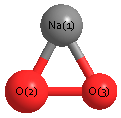Vibrational Frequencies calculated at MP2=FULL/3-21G*
| Mode Number |
Symmetry |
Frequency
(cm-1) |
Scaled Frequency
(cm-1) |
IR Intensities
(km mol-1) |
Raman Act
(Å4/u) |
Dep P |
Dep U |
|---|
| 1 |
A1 |
968 |
918 |
0.19 |
1284.95 |
0.41 |
0.58 |
| 2 |
A1 |
459 |
435 |
38.71 |
2.40 |
0.65 |
0.79 |
| 3 |
B2 |
499 |
473 |
185.26 |
72.11 |
0.75 |
0.86 |
Unscaled Zero Point Vibrational Energy (zpe) 962.9 cm
-1
Scaled (by 0.948) Zero Point Vibrational Energy (zpe) 912.8 cm
-1
See section
III.C.1 List or set vibrational scaling factors
to change the scale factors used here.
See section
III.C.2
Calculate a vibrational scaling factor for a given set of molecules
to determine the least squares best scaling factor.
